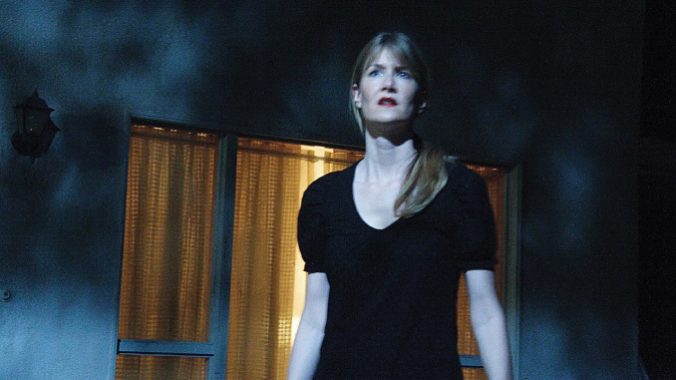Triple Threat: David Lynch’s L.A. Trilogy
With Lost Highway, Mulholland Dr., and Inland Empire, Lynch shattered the concept of identity.

A story has a beginning, a middle, and an end. Maybe that’s why the trilogy is such a satisfying structure for so many epic series or curious corners of cinema history. This year in Triple Threat, Ken Lowe revisits another of cinema’s best trilogies each month, including some unofficial trilogies that have come to define a director, actor, or time in film history. You can follow the series here.
David Lynch is not a director who values exposition, so his movies are not the sort for “askers,” those folks who, in the middle of the movie, need to ask what is happening, who is he, is this a flashback, and so forth. More than other movies of his—and especially more than that most popular thing he ever contributed to the discourse, TV’s Twin Peaks—Lynch’s three films Lost Highway, Mulholland Dr. and Inland Empire are seemingly made entirely to dismay and demoralize the asker-type viewer. When asked if Lynch was joking when he ordered a producer to locate a one-legged woman, a monkey and a lumberjack for a scene in his movie, Inland Empire star and previous Lynch collaborator Laura Dern reportedly reminded the producer that he was working on a David Lynch movie.
Lynch’s unofficial L.A. trilogy spanned from 1997 to 2006, a period of time where the old analog world drifted into the past and a digital one increasingly rose to prominence. There isn’t anything in Lynch’s three movies about social media, the internet, or the constant and harrowing nature of self-surveillance that we imposed upon ourselves during those exact years. The biggest questions at the heart of all three movies are about identity: Who are the main characters, really? (Not just in the sense of “Who are they as a character?” but literally “Who is actually the main character?” That’s a question you’ll find yourself asking more than once while giving these a watch.) It feels like these movies couldn’t have come out at any other time, even if they aren’t about the particulars of how we’ve come to completely and consciously commodify and cultivate our own identities.
Noir that’s set in Los Angeles is something of a distinct subgenre, always about a juxtaposition between the glamor of Hollywood or the country’s most modern city with the blood and betrayal mixed into its concrete. For Lynch, the juxtaposition in these movies is instead between his characters’ visions of themselves and the harshness of intruding reality. (At least I think so. These are movies that reject easy interpretation.)
When you sit down for these movies, you are in for hours of being unsure what you’re seeing, and in the case of Inland Empire, of being about as sure of what you’re seeing as the director and actors apparently were. They can be a tough watch. They are also some of the only movies I’ve ever seen that replicate the uneasy logic of nightmares, the brooding vindictiveness of daydreaming about being some terrible person you think you wish you were.
You will also see a one-legged woman, a monkey, and a lumberjack. I don’t know why they’re there, either.
The Movies
Lost Highway begins with Fred (Bill Pullman, just a year after he blew up aliens for America and God in Independence Day) and Renee (Patricia Arquette), a married couple who seem to live an inert life together. Fred is a jazzman who can’t seem to perform in bed and who suspects Renee is messing around on him. They keep receiving eerie VHS tapes that could only have been filmed inside their own home, while they are asleep. Then, one of them depicts Fred having killed Renee. He does not remember this, but he takes the fall for her murder.
Then, in prison, something completely inexplicable happens. The security guards check on Fred and find that he is not Fred. Inside the cell, for no reason anybody at the jail can figure out, is Pete (Balthazar Getty), a young mechanic with a bitchin’ jacket and a rap sheet, sure, but there’s no reason he should’ve been incarcerated. Completely baffled, the authorities release him to the parents he lives with, who seem uncertain how he got there. It’s implied, heavily, that Pete was injured or killed on some night during which he and his girlfriend fought. Pete returns to his job, which largely consists of tuning the car of Mr. Eddy (Robert Loggia, also an Independence Day alum!).
Pete’s life is complicated further when Mr. Eddy’s lover, also played by Patricia Arquette but not the same character, we think) ensnares him with sex and promises of running away. It all descends into a lot of violence and bad choices, before Pete turns back into Fred. It’s clear (well… it’s arguably clear) that Fred has built another bad-boy persona for himself, a badass who will live in a dangerous world and take what he wants. How much of that is real and how much of it is in his head seems to be up to us to decide.
-

-

-

-

-

-

-

-

-

-

-

-

-

-

-

-

-

-

-

-

-

-

-

-

-

-

-

-

-

-

-

-

-

-

-

-

-

-

-

-








































